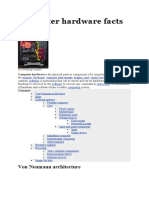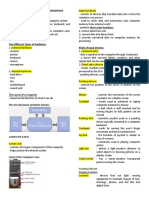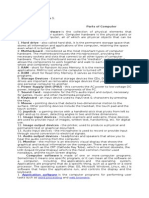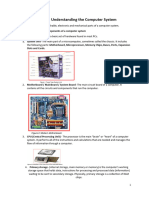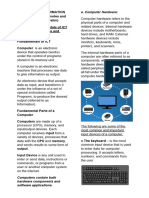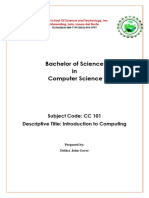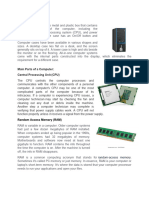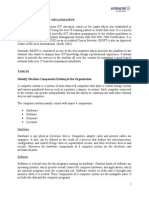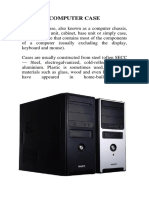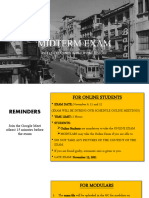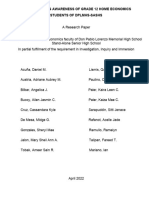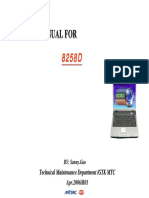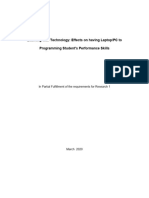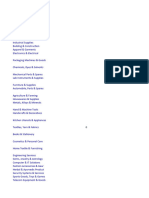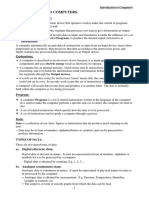COMPUTER
What is Computer?
A computer is an electronic device that manipulates
information, or "data." the computer sees data as one's and
zero's but he knows how to combined them into more
complex things such as a photograph, a movie, a website, a
game and much more.
Computer use a combination of "Hardware" & "Software"
Hardware is any physical part of the computer which include all the
internal components and also the external part like the monitor and the
keyboard.
Software is any set of instructions that tells the hardware what to do such as
a web browser, media player or word processor.
Proponent
CHARLES BABBAGE
Father of Computer
He invented the Analytical Engine & Difference Engine
Analytical Engine
Designed to perform complex mathematical
calculations
Considered the first fully automatic calculating
machine
Introduced concepts that are fundamental to
contemporary computers, such as programmability
and general-purpose computation
Designed to evaluate any mathematical formula
Difference Engine
Designed to calculate and tabulate polynomial
functions
Used metal wheels and levers to store numbers and
make calculations
Intended to simplify everyday adding and
multiplication tasks
BY: JRMA
�Types of Computers
The four basic types of computers are as under:
Supercomputer
Mainframe Computer
Minicomputer
Microcomputer
Supercomputer
The most powerful computers in terms of performance and data processing are the
Supercomputers. These are specialized and task specific computers used by large
organizations. The supercomputers are very expensive and very large in size. It can
be accommodated in large air-conditioned rooms; some super computers can span
an entire building.
Proponent
SEYMOUR CRAY
Father of Supercomputer
Designed the world's fastest, most powerful
supercomputers.
Designed the CDC 6600, which is widely considered
the first supercomputer.
CDC 6600
The CDC 6600 was a mainframe computer and
the first successful supercomputer. It was
designed by Seymour Cray and manufactured
by Control Data Corporation (CDC). The CDC
6600 was delivered in 1964 and was the world's
fastest computer until 1969.
BY: JRMA
�Mainframe computer
Although Mainframes are not as powerful as supercomputers, but certainly theyare
quite expensive nonetheless, and many large firms & government organizations
uses Mainframes to run their business operations. Banks educational institutions &
insurance companies use mainframe computers to store data about their customers,
students & insurance policy holders.
Minicomputer
Minicomputers are used by small businesses & firms. Minicomputers are also
called as “Midrange Computers”. These are small machines and can be
accommodated on a disk with not as processing and data storage capabilities as
super-computers & Mainframes.
Microcomputer
Desktop computers, laptops, personal digital assistant (PDA), tablets &
smartphones are all types of microcomputers. The micro-computers are widely
used & the fastest growing computers. These computers are the cheapest among
the other three types of computers.
BY: JRMA
�Other Devices uses a computer
A. Mobile phones
B. Tablets
C. Game consoles
D. TV's
The PC System
As a technician, you should know and be able to identify the components found in
a typical personal computer system. The PC is modular by design. It is called a
system because it includes all the components required to make a functional
computer.
Types of Computers
Workstation
A workstation is a high-end personal computer designed
for technical or scientific applications. Intended primarily
to be used by one person at a time, they are commonly
connected to a local area network and run multi-user
operating systems.
Desktop computer
Desktop computers come in a variety of styles ranging from
large vertical tower cases to small form factor models that
can be tucked behind an LCD monitor. In this sense, the
term 'desktop' refers specifically to a horizontally-oriented
case, usually intended to have the display screen placed on
top to save space on the desk top. Most modern desktop
computers have separate screens and keyboards.
Laptop
A laptop computer or simply “laptop”, also called a
notebook computer or sometimes a notebook, is a small
personal computer designed for portability.
BY: JRMA
� Parts of Computer
System unit – The main computer cabinet usually referred
to as a case, housing the primary components of the system.
This includes the main logic board (System board or mother
board), processor, memory, disk drives, switching power
supply, and the interconnecting wires and cables. The system
unit also includes expansion cards to provide audio, video,
networking and other functionality. Expansion cards vary from system to system.
Keyboard – The most familiar computer input device, the
keyboard is used to introduce characters and commands into
the system.
A central processing unit (CPU), also referred to as a
central processor unit, is the hardware within a computer
that carries out the instructions of a computer program by
performing the basic arithmetical, logical, and input/output
operations of the system.
A motherboard (sometimes alternatively known as the
mainboard, system board, planar board or logic board, or
colloquially, a mobo) is the main printed circuit board (PCB)
found in computers and other expandable systems. It holds
many of the crucial electronic components of the system, such
as the central processing unit (CPU) and memory, and
provides connectors for other peripherals. Unlike a backplane,
a motherboard contains significant sub-systems such as the
processor.
A video card (also called a video adapter, display card,
graphics card, graphics board, display adapter or
graphics adapter) is an expansion card which generates a
feed of output images to a display. Most video cards offer
various functions such as accelerated rendering of 3D
scenes and 2D graphics, MPEG- 2/MPEG-4 decoding, TV
output, or the ability to connect multiple monitors (multi-
monitor).
BY: JRMA
� A network interface controller (NIC) (also known as a
network interface card, network adapter, LAN
adapter and by similar terms) is a computer hardware
component that connects a computer to a computer
network.
A sound card (also known as an audio card) is an
internal computer expansion card that facilitates the input
and output of audio signals to and from a computer under
control of computer programs. The term sound card is
also applied to external audio interfaces that use software
to generate sound, as opposed to using hardware inside
the PC. Typical uses of sound cards include providing the
audio component for multimedia applications such as
music composition, editing video or audio, presentation,
education and entertainment (games) and video
projection.
Random-access memory (RAM) is a form of
computer data storage. A random-access device
allows stored data to be accessed directly in any
random order. In contrast, other data storage media
such as hard disks, CDs, DVDs and magnetic tape,
as well as early primary memory types such as
drum memory, read and write data only in a
predetermined order, consecutively, because of
mechanical design limitations. Therefore, the time
to access a given data location varies significantly
depending on its physical location.
A hard disk drive (HDD) is a
data storage device used for
storing and retrieving digital
information using rapidly
rotating discs (platters) coated with magnetic material.
An HDD retains its data even when powered off. Data is
read in a random-access manner, meaning individual
blocks of data can be stored or retrieved in any order
rather than sequentially. An HDD consists of one or more
rigid ("hard") rapidly rotating discs (platters) with
BY: JRMA
� magnetic heads arranged on a moving actuator arm to
read and write data to the surfaces.
A power supply unit (PSU) converts
mains AC to low-voltage regulated DC power for the internal
components of a computer. Modern personal computers
universally use a switched-mode power
supply. Some power supplies have a
manual selector for input voltage,
while others automatically adapt to the
supply voltage.
A computer case is also known as a "computer
chassis", "tower", "system unit", "base unit" or simply
"case". Also sometimes incorrectly referred to as the
"CPU" or "hard drive", it is the enclosure that contains
most of the components of a computer. Form factors
typically specify only the internal dimensions and layout
of the case. For rack-mounted and blade servers form
factors may include precise external dimensions as well,
since these cases must themselves fit in specific
enclosures
Mouse – An input device used with graphical user interfaces
(GUI) to point to, select, or activate images on the video
monitor. By moving the mouse along a surface, the user can
cause a cursor on the display to move in a corresponding
manner.
Video display or Monitor – A Visual output device that
displays characters and graphics on screen.
Speakers – Audio output devices used to deliver voice, music and coded
messages.
BY: JRMA
� Printers – A hard copy output device that applies data to paper. Normally,
methods of placing information on a page include dot-matrix printer, inkjet printer
and laser printer.
BY: JRMA


